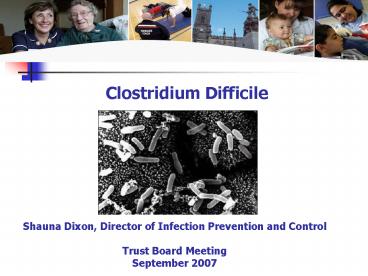Clostridium difficile - PowerPoint PPT Presentation
1 / 20
Title:
Clostridium difficile
Description:
Major cause of antibiotic associated diarrhoea and colitis ... Lockers, trolleys. Curtains. Commodes. Toilets. Bed pans. Scales. Mops. Health Care Workers ... – PowerPoint PPT presentation
Number of Views:44
Avg rating:3.0/5.0
Title: Clostridium difficile
1
Clostridium Difficile
Shauna Dixon, Director of Infection Prevention
and Control Trust Board Meeting September 2007
2
Clostridium Difficile
- Major cause of antibiotic associated diarrhoea
and colitis - Bug is a gram positive, anaerobic, spore forming
organism - First described 1935 Hall OToole
- 1977 toxins from stool/faecal samples produced a
cytopathic effect in cell culture
- 1978 C. difficile identified as the source of the
toxins and cause of pseudomembranous colitis
3
Clostridium Difficile
- Acquired by faecal oral route
- Persists in the environment
- Contamination is common in-
- Hospitals
- Nursing homes
- Has been readily detected on healthcare workers
hands
4
Clostridium Difficile Spores
- Patients Environment
- Bedding
- Lockers, trolleys
- Curtains
- Commodes
- Toilets
- Bed pans
- Scales
- Mops
- Health Care Workers
- Hands
- Rings
- Stethoscopes
5
Signs Symptoms
- Diarrhoea often described as having a strong
farm yard smell - Abdominal pain
- Elderly patients may become seriously ill with
dehydration - Severe form of disease Pseudomembranous colitis
6
Who is at Risk
- Mostly affects elderly patients 65 years
- Clostridium difficile is usually acquired in
hospital or care home settings - Now nationwide increasing reports of community
acquired infections - Patients who are taking or have recently had
antibiotic treatment - Serious outbreaks of C. difficile have been
reported in hospitals (Stoke Mandeville
2005/2006)
7
Criteria for Testing and Reporting C.difficile
What is the case definition for surveillance?
Any diarrhoeal specimen that is toxin positive
in patients 2 years ? 65 years where the patient
has not been diagnosed with C.Difficile in
proceeding 4 weeks. Who reports what? The
Trust laboratory that processes the stool sample
reports all cases including those considered to
be community acquired, those from patients in
community and PCT hospitals, mental health
trusts, nursing and residential homes
8
Clostridium Difficile Infections
- 2001 - 22008
- 2002 - 28986
- 2003 - 35537
- 2004 - 43672
- (Voluntary Reporting England, Wales, NI)
- 2004 - 44488
- 2005 - 51767
- 2006 - 55681
- (England Mandatory Reporting)
- FIGURES ARE INCREASING
9
Clostridium difficile NW Trusts Jan-Dec 2006
- 1 Aintree 9 East Lancashire 17 Royal
Liverpool Childrens 25 Pennine - 2 Blackpool, Fylde Wyre 10 Lancashire
Teaching Hospital 18 Salford Royal
26 Walton - 3 Bolton 11Liverpool Womens 19 South
Manchester 27 Trafford - 4 Central Manchester Man.Childrens 12 Mid
Cheshire 20 Southport Ormskirk 28
Wirral - 5 Christie Hospital 13Morecambe Bay 21 St
Helens Knowsley 29 Wrightington - 6 Clatterbridge Centre for Oncology 14 North
Cheshire 22 Stockport - 7 Countess of Chester 15 North Cumbria 23
Tameside Glossop - 8 East Cheshire 16 Royal Liverpool
Broadgreen 24 Cardiothoracic Centre, Liverpool
10
Reducing Clostridium Difficile Infections
- Infection Control Practices
- Hand washing before and after contact with the
patient or their environment - Alcohol gel is NOT effective against Clostridium
difficile - Wear single use personal protective clothing
(aprons/gloves) - Dispose of as clinical waste and wash hands after
removal - Facilitate handwashing of patients after
toileting and before eating
11
Reducing Clostridium Difficile Infections
- Isolation/cohorting of affected patients until
48-72 hours symptom free. (Risk assess with the
Infection Control Team) (ICT) - Isolate in a side room if possible
- Follow the C.difficile and enteric precautions
Infection Control Policy (new policy on
C.difficile for nursing/residential homes) - Nursing/residential homes to inform the community
ICN should any other patients develop diarrhoea.
12
Reducing Clostridium Difficile Infections
- Environmental Cleaning
- Cleaning of the patients environment and
reusable equipment with a chlorine based
disinfectant. - Use disposable equipment where possible dispose
of as clinical waste. - Cleaning schedule to be increased for C.
difficile patients.
13
Reducing Clostridium Difficile Infections
- A Multifaceted Approach
- Antibiotic Stewardship
- Sensible antibiotic prescribing
- Narrow spectrum agents
- Restrict use of cephalosporins and quinolones
14
- Robust antibiotic guidelines
- Arrange workshops for Oldham GPs to
discuss antibiotic policy and audits. - Joint partnership working has been
established with Pennine Acute to address
this issue.
15
Saving Lives 2005High Impact
InterventionClostridium difficilePrevention
better than Cure
16
- High Impact Interventions
- Five key elements have been described as being
necessary to reduce the incidence of Clostridium
difficile. They include- - Prudent antibiotic prescribing
- Prescribe antibiotics as per local policy
- Hand Hygiene
- Wash hands with soap and water before and after
each patient contact - Implement cleanyourhands campaign across the
community.
17
- Enhanced Environmental Cleaning
- Use chlorine based disinfectant to reduce
environmental contamination with Clostridium
difficile spores as per local policy - Isolation
- Always use a single room if available
- Cohort patient care should be applied if
single room is not available - Personal Protective Equipment
- Always use disposable gloves and apron when
handling body fluids and when caring for CDAD
infected patients
18
- Regular audit observations
- Feedback results of reviews of practice to staff
- Discuss findings
- Make any changes
- Re audit observations
19
Environmental Cleaning
20
Conclusion
- Patient morbidity/mortality
- 5 reduction target set for Pennine Acute
- Code of Practice- legislation
- Challenge to primary secondary care
- Needs a collaborative approach































